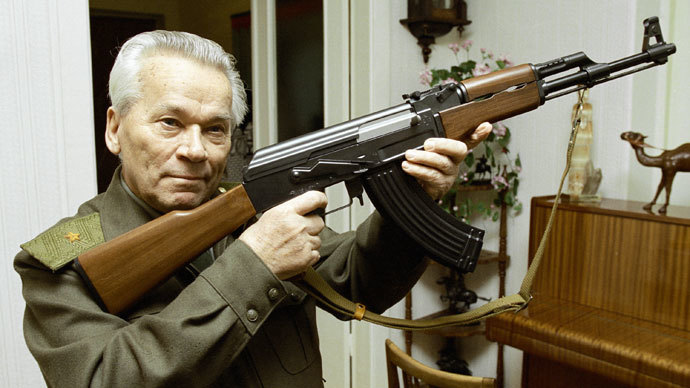'Am I guilty?' AK-47 maker's near-death torment

In the last years of his life, Mikhail Kalashnikov, the famous Russian weapon designer, anguished over his responsibility for the millions of deaths his inventions caused, his published letter to the head of the Russian Church reveals.
In his public interviews Kalashnikov, who died last month at the age of 94, insisted that he created the AK-47 assault rifle and dozens of other firearms as a means to protect his country, and rejected responsibility for killings perpetrated by militants and terrorists using his weapons.
But, apparently, as he was approaching the end of his life doubts lingered in his mind. Kalashnikov, who found faith in his final years, shared the burden in a letter to the head of the Russian Orthodox Church, which was published on Monday by the Izvestia newspaper.
“My soul ache is unbearable and has one irresolvable question: if my rifle took lives, does it mean that I, Mikhail Kalashnikov, aged 93, a peasant woman’s son, an Orthodox Christian in faith, is guilty of those people’s deaths, even if they were enemies?” the leaked letter reads.
The letter was written in April last year, the newspaper reported, and focuses on Kalashnikov’s experience of world-changing events, including the Nazi invasion of 1941 and the dissolution of the Soviet Union in 1991. He said in both cases the Russian people sought refuge in religion to cope with the turmoil in their lives.
Kalashnikov himself, even though he was baptized as a child, spent most of his life as an atheist living in an officially atheist country. It was only at the age of 91 that he felt the call of faith and answered it, he wrote.
The inventor also shared his confusion over why God allows evil to exist in the world, a misfortune that puzzled many minds before him.

“Good and evil coexist side by side, fighting and, worst of all, they resign themselves to each other in the hearts of people - that is what I have come to at the end of this earthly life. It’s similar to the kind of perpetual motion I wanted to invent in my younger years,” he wrote
The daily provides photos of the two-page letter. It’s printed rather than hand-written and has two photos of the weapons designer himself, as well as a decorative border and a signature. It also carries a date mark “09.06.2012”, similar to those used by archives to sort paperwork, which may contradict the reported date of writing.
Critics of the Russian Orthodox Church were quick to brand the letter as either a fake or an attempt to score publicity points over Kalashnikov’s death.
But Patriarch Kirill’s office confirmed that the letter was authentic. It said that the Orthodox Church does not condemn making weapons for the defense of one’s motherland, or using them against aggressors, Izvestia reports.
Kalashnikov’s daughter Elena, who had recently been acting as his personal assistant, said the letter was not sent through her and was probably penned by her father together with the prior of a cathedral in Izhevsk.
The church, which was demolished in 1937 and rebuilt in the mid-2000s, is mentioned in the letter as a place of great spiritual importance for the inventor. Kalashnikov wrote that he was glad that he rejected the idea of building a museum dedicated to him in the place where the church was located, because otherwise it might not have been reconstructed.
It’s not uncommon for inventors of instruments of death to take drastic steps in their later years to change their legacy. One of the most famous examples is Alfred Nobel, whose wealth was founded on dynamite. He was disturbed to read his premature obituary published erroneously in a newspaper, which branded him a “merchant of death”. It inspired him to allocate a greater portion of his fortune to establish the Nobel Prizes.
Another famous weapons designer, J. Robert Oppenheimer, was overwhelmed by the destructive power of the nuclear weapons he helped to create under the Manhattan Project. He became a vocal proponent of nuclear nonproliferation, a position which eventually cost him his security clearance and political influence.














